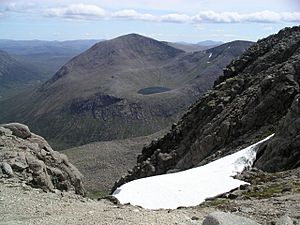Natural history of Scotland facts for kids
Scotland is a country in Europe known for its amazing natural world. The natural history of Scotland is all about its plants (called flora), animals (called fauna), and fungi (called mycota). It's a place with many different kinds of living things.
Contents
Plants of Scotland (Flora)

Scotland's plants are a mix of native species. There are over 1,600 types of vascular plants. These are plants with special tissues to carry water and nutrients. You can also find more than 1,500 kinds of lichens. Lichens are like a mix of fungi and algae. Plus, there are nearly 1,000 types of bryophytes. Bryophytes are small plants like mosses and liverworts.
Even though Scotland has fewer vascular plant species compared to some other parts of the world, its lichens and bryophytes are very important. They are found in large numbers and are globally significant.
Special Plants and Trees
Scotland is home to some rare ferns. In the 1800s, collectors almost made some of these ferns disappear. The plants here are typical for north-west Europe. You'll see boreal forests, especially the Caledonian Forest. This forest used to be much bigger. There are also wide areas of heather moorland and coastal machair. Machair is a special type of grassy plain found near the sea.
Many plants that are not native to Scotland have also arrived. About 43% of the plant species in the country now are not originally from here.
Scotland has some very important trees. A Douglas fir tree near Inverness is the tallest tree in the United Kingdom. The Fortingall Yew tree might even be the oldest tree in all of Europe!
Unique Scottish Plants
Some flowering plants are found only in Scotland. These are called endemic species. Two examples are the Shetland mouse-ear and the Scottish primrose. There are also many unique mosses and lichens that only grow here.
You can find many stories, songs, and poems about Scotland's plants. They are a big part of the country's culture.
Animals of Scotland (Fauna)
The animals of Scotland are generally like those found in north-west Europe. However, some of Scotland's larger mammals were hunted until they became extinct a long time ago. Scotland has many different temperate environments. These places support 62 different kinds of wild mammals. This includes a group of wild cats and many grey and harbour seals.
Birds of Scotland
Many birds live on the moorlands. These include the blackcock and the famous red grouse. Scotland also has very important places where seabirds build their nests. Birds like the northern gannet come here to lay their eggs.
The golden eagle is a national symbol of Scotland. White-tailed eagles and ospreys have recently come back to live in Scotland again. The Scottish crossbill is a special bird. It is the only vertebrate species (an animal with a backbone) that is found only in the British Isles.
Marine Life and Fish
Scotland's seas are some of the richest in the world for living things. Experts believe there are over 40,000 different kinds of marine species in Scotland's waters. This includes the Darwin Mounds. These are important cold-water coral reefs found in 1988.
Inland, nearly 400 different groups of Atlantic Salmon live in Scotland's rivers. There are 42 types of fish in Scotland's fresh waters. About half of these fish arrived naturally, and the other half were brought by humans.
Other Animals
Only six types of amphibians (like frogs and newts) and four types of land reptiles (like lizards) are native to Scotland. But many kinds of invertebrates (animals without backbones) live here. Some of these are rare in the United Kingdom. It is thought that about 14,000 types of insects live in Scotland. This includes rare bees and butterflies that are protected by special plans.
Fungi of Scotland (Mycota)
About 1,650 different kinds of fungi are found in Scotland. One very rare fungus is the Phelloden confluens. It is found in only a few small areas.
Tiny Organisms (Micro-organisms)
Syringammina fragilissima is a special type of tiny organism. It is found off the coast of Scotland, near Rockall. This organism is the largest single-celled organism known! It can grow up to 20 centimeters (about 8 inches) across. It was first discovered in 1882.
Protecting Nature (Conservation)
Protecting the natural environment is very important in Scotland. Many groups work to take care of the country's plants and animals. Agencies in the UK are worried about climate change. They think it could harm many of Scotland's plants and animals, especially those living on mountain plateaus and in the marine areas.
Where to See Scottish Wildlife
You can take boat tours in the Hebridean waters to see whales, dolphins, porpoises, and basking sharks in their natural homes. Other great places to see Scottish wildlife include:
- Highland Wildlife Park
- Loch Lomond and the Trossachs National Park
- Cairngorms National Park
- Forestry Commission (Scotland)
- Central Scotland Forest Trust


